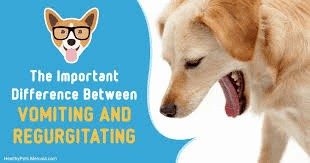When companion animals bring food back up, most owners notice a problem. What you may not know, is there are two different mechanisms for spitting up. food – vomiting and regurgitation.

Vomiting is when the contents of the stomach and upper intestine are forcefully ejected – owners will see abdominal effort as the material is heaved up; regurgitation occurs when contents of the mouth, pharynx, or esophagus are expelled. For example, when dogs with megaesophagus (dilation of the esophagus) regurgitate, the food simply comes back up from the esophagus and is a very passive event.
Related: The Vomiting Cat – Consider Triaditis
The most notable signs of vomiting are nausea (drooling) and abdominal heaving. Pets also tend to look apprehensive when nauseated. Some dogs and cats may have grumbling/growling stomach sounds (borborygmi).

Regurgitation is less intense. It’s more of a burp in which some of the contents in the esophagus, either liquid or solid, come back up without the heaving and noticeable effort. Although there might be some gagging or a bit of coughing as the contents move up, there’s no forceful abdominal effort involved. Usually, the food brought up is undigested and is covered with mucus. Regurgitation generally happens quite soon after the pet eats.
Basically, vomiting is an active effort, whereas regurgitation is pretty passive.

It’s not always easy to distinguish the product of vomiting from that of regurgitation, but some things your veterinarian will consider are:
- Heaving, retching, or abdominal compression doesn’t occur with regurgitation, but can with vomiting.
- The regurgitated bolus (a lump of food the amount of a single swallow) is usually tubular in shape.
- The regurgitated bolus usually has a neutral or alkaline pH. If the food made it to the stomach prior to being regurgitated, however, the pH may be acidic (as vomited food would be). Vomit which occurs from the upper intestine or stomach is very acidic as the stomach is a very acidic place. Your veterinarian may test the expelled material’s pH level.
- A regurgitated bolus does not have bile in it where as vomited food may
It is very helpful to know whether the food came up from vomiting versus regurgitation as the underlying cause can be very different.
Causes of regurgitation include:
- Megaesophagus
- Sphincter issues
- Neuropathic causes
- Esophageal irritation and more
Vomiting has an extensive list of causes that include:
- Infectious diseases (parvovirus, coronavirus, leptosporosis to name a few)
- Toxin exposure
- Inflammatory diseases such as pancreatitis
- Intestinal parasitism
- Foreign body obstruction
- Cancer (usually older pets)
- Dietary indescretion
- Endocrine / Metabolic disease including issues affecting the liver and/or kidneys
- Autoimmune diseases such as IBD
- Many more
Knowing what to watch for can help you help your veterinarian diagnose and treat your pet appropriately faster!


